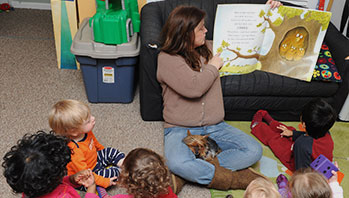- key (or other object from Discovery Time)
- question
- sink
MA Standards:
Literature/RL.PK.MA.1: With prompting and support, ask and answer questions about a story or a poem read aloud.
Literature/RL.PK.MA.10: Listen actively as an individual and as a member of a group to a variety of age-appropriate literature read aloud.
Literature/RL.PK.MA.9: With prompting and support, make connections between a story or poem and one’s own experiences.
Language/L.PK.MA.1.d: Understand and use question words (e.g., who, what, where, when, why, how)
Head Start Outcomes:
Literacy Knowledge/Book Appreciation and Knowledge: Asks and answers questions and makes comments about print materials.
PreK Learning Guidelines:
English Language Arts/Reading and Literature 6: Listen to a wide variety of age appropriate literature read aloud.
English Language Arts/Reading and Literature 10: Engage actively in read-aloud activities by asking questions, offering ideas, predicting or retelling important parts of a story or informational book.
Read Together: Who Sank the Boat? #1

© Commonwealth of Massachusetts, Department of Early Education and Care (Jennifer Waddell photographer). All rights reserved.
STEM Key Concepts: Objects behave differently in water; Some things float; Some things sink; If you add enough weight to a floating object, it will sometimes sink; Solids have physical characteristics that can be observed and described
ELA Focus Skills: Active Listening, Compare and Contrast, Comprehension, Phonological Awareness (Rhyme and Repetition), Sequencing, Vocabulary
Before You Read
Show children the cover of Who Sank the Boat? Point to the question mark and tell children that the mark means the words are asking a question. Read the title aloud. Then ask,
- What do you think the book will be about?
- Do you think we will find out the answer to the question, “Who sank the boat?”
Set a listening focus for children by asking them to notice and think about why the boat sinks further into the water each time an animal gets in.
As You Read
Read slowly, with rhythm and expression. Hold the book so everyone can see the pages as you read.
- Encourage children to chant the repetitive question, “Do you know who sank the boat?”
- Use the illustrations to clarify the meanings of unfamiliar words such as bay, bow and knit.
- Pause on the illustration of the cow sitting in the boat and ask, Why do you think one end of the boat is sinking and not the other end?
- Pause on the illustration of the pig getting in the boat. Ask, What do you think will happen if the pig tilts the boat more?
- Pause on the last illustration. Ask, What is happening to the boat? Why is that happening?
After You Read
Help children understand that as the boat got fuller it got lower in the water, and finally the little mouse added that last bit of weight that caused the boat to sink. Ask questions such as,
- If the mouse was already in the boat and the cow got in last, do you think the boat would still sink? Why do you think that?
- Do you think the boat would sink if the little mouse didn’t get in at all? Why do you think that?
Take It Further: You may want to talk about the word sank. Explain to children that the word sank means something that already happened. Say, If I put this <key> in the water it will sink. It is happening right now. When you put it in the water yesterday, it sank. It already happened.
Take It Further: Help children grasp how the boat could hold only so much weight before it tipped over. Use a balance scale from the Science and Math Center. Point out how the scale is balanced, or each side is the same height. Explain that this is what the boat was like before the animals got in. Then place an object on one side of the scale to show how the balance is off. Relate it to the cow getting in the boat. Continue until one side of the scale is as low as it can go and tell children this is like the boat when it tipped over—there was too much weight in the boat. Take one item out and ask children what they think would happen to the boat if the <pig> came out and the mouse went in?
English Language Learners: Help children understand the difference between sink and sank. Have a bowl of water and two coins available to use in demonstrating. Give child a penny and you take a penny. Have the child put the penny in the bowl. Wait about a minute and say, I see you sank your penny already. Then take your penny and say, Watch me sink my penny right now. Drop it in the water. Continue until children grasp meaning.
